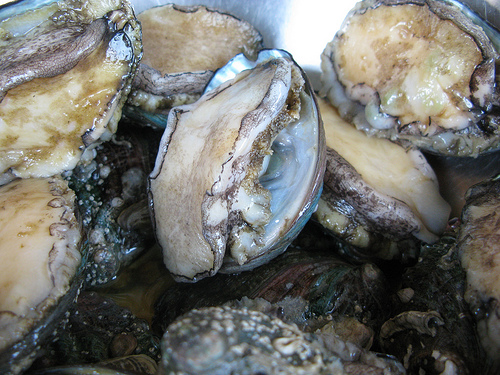Filipinos think of something foreign whenever they hear the word abalones. There are however, three known species of abalone endemic in our marine waters. These are the donkey’s ear abalone Haliotis asinina (lampas or sobra-sobra), H. varia (kapinan), and H. ovina. There are commercial abalone farms in the provinces of Iloilo, Guimaras, Negros, Samar, Surigao, Zamboanga, Palawan, and Tawi-tawi.

Abalones are ear-shaped mollusks that belongs to genus Haliotis which means sea ear. They live in shallow waters and feed on small algae or diatoms. They are easily distinguished from other mollusks because the respiratory pores are evident along the margin of its shell. Abalone meat, fresh, canned, or dried, command high prices because of its firm meat texture, and exceptional and delicate flavor.
Abalone is popular in international cuisine in Japan, China, Europe, Australia, USA, and Mexico. In Japan, the most popular dish prepared from abalones is sushi and sashimi, while the favored western styles are grilled and deep-fried.
Since abalones are slow-growing mollusks, producers find it hard to sustain its production after the initial harvest. Another problem that causes the decline is the depletion of algae, which is its natural food resource, due to varying water current and water pollution.
With the advent of new technologies, it is now possible to culture and multiply abalones in tanks and large containers. It is easy to monitor and regulate abalone seed production if reared in captivity. The Southeast Asian Fisheries Development Center in Tigbauan, Iloilo developed this tank-rearing method.
Seed Production
Abalones in captivity attain sexual maturity within 6-8 months with a shell size of 35-40 mm. They are reared in fiberglass or concrete spawning tanks with flow-through sand-filtered seawater.
Female abalones have dark green gonad, while the males have milky-white gonad. In mollusks, the gonad is the reproductive organ found protruding between the shell and foot muscle, and is responsible for releasing the gametes or eggs during mating. Gonads mature easily when there is proper nutrition, high water temperature, and longer photoperiod (amount of daylight).
Spawning, or the act of releasing the gametes of either sex usually occurs between one and three o’clock in the morning. Male abalones release their milt (gamete) earlier and this triggers spawning in mature females. A single male abalone is enough to fertilize 3-4 female abalones. A mature female (50-80 mm shell length) releases 100,000 to 1 million eggs at one spawning period. The time interval between two successive spawning may vary from 13 to 37 days. Ten spawning tanks with 50-60 breeders can provide a stable supply of eggs and larvae throughout the year.
To maximize abalone seed production, collect the fertilized eggs early in the morning, between six to seven o’clock. Place the larvae in rearing tanks with pre-grown diatoms. One can culture diatoms by placing 50-60 pieces plates vertically in a 1-ton oval tank. Fill the tanks with filtered-seawater with a depth of 40-50 cm and hold under ambient light. Seawater should flow continuously until the plate surface turns pale greenish-brown (indicating growth of diatoms).
Nursery rearing
Place about 150,000 to 300,000 larvae in a one-ton tank with sand-filtered seawater. On the fifth day of stocking, provide the tanks with mild aeration and place under ambient light. Provide artificial lighting at night by using 40-watt fluorescent lamps. Rear the larvae in tanks up to 60 days until they reach the juvenile size, 5 to 10 mm.
Culture early juveniles in PVC pipes cut in half. Sustain them with fresh seaweeds for 70-80 days or until they reach a shell length of 30 mm.
It is important that to have a continued supply of sand-filtered seawater to maintain good water quality.
Grow-out
Abalones cultured in flow-through tanks or in sea-cages reach its marketable size, 55-60 mm shell length, within 8-10 months. Stocking rate is 60-100 per cage. In tank culture, it is important to maintain sufficient and continuous in-flow of sand-filtered seawater. For ease in feeding and maintenance, place the abalone in perforated plastic buckets suspended in tanks. Provide fresh seaweeds at weekly intervals.
—————
For further information, please contact: SEAFDEC Aquaculture Department, Tigbauan 5021, Iloilo, Philippines or at Tel: (63 33) 336 2937, 336 2965 Email: [email protected])
by Mary Charlotte O. Fresco, BAR Chronicle, January 2002 Issue (Vol. 3 No. 1-2)

